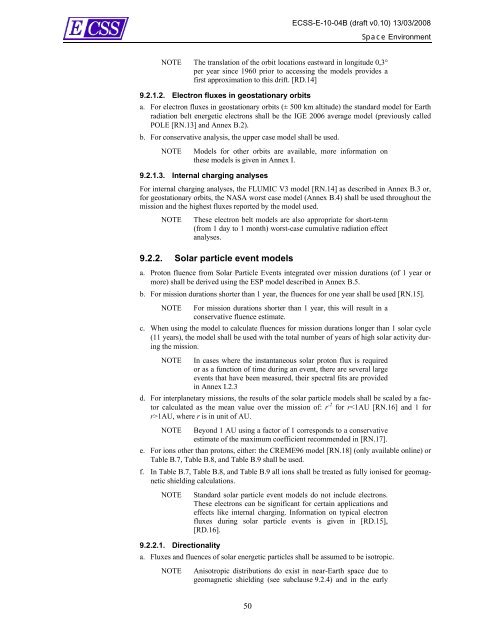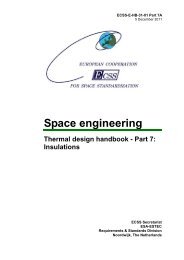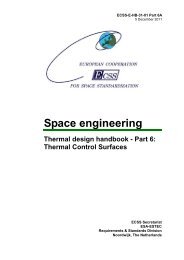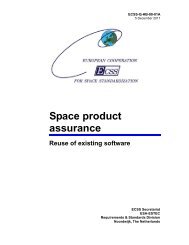ECSS E 10-04 v0.10 - European Cooperation on Space Standardization ...
ECSS E 10-04 v0.10 - European Cooperation on Space Standardization ...
ECSS E 10-04 v0.10 - European Cooperation on Space Standardization ...
You also want an ePaper? Increase the reach of your titles
YUMPU automatically turns print PDFs into web optimized ePapers that Google loves.
50<br />
<str<strong>on</strong>g>ECSS</str<strong>on</strong>g>-E-<str<strong>on</strong>g>10</str<strong>on</strong>g>-<str<strong>on</strong>g>04</str<strong>on</strong>g>B (draft v0.<str<strong>on</strong>g>10</str<strong>on</strong>g>) 13/03/2008<br />
<strong>Space</strong> Envir<strong>on</strong>ment<br />
NOTE The translati<strong>on</strong> of the orbit locati<strong>on</strong>s eastward in l<strong>on</strong>gitude 0,3°<br />
per year since 1960 prior to accessing the models provides a<br />
first approximati<strong>on</strong> to this drift. [RD.14]<br />
9.2.1.2. Electr<strong>on</strong> fluxes in geostati<strong>on</strong>ary orbits<br />
a. For electr<strong>on</strong> fluxes in geostati<strong>on</strong>ary orbits (± 500 km altitude) the standard model for Earth<br />
radiati<strong>on</strong> belt energetic electr<strong>on</strong>s shall be the IGE 2006 average model (previously called<br />
POLE [RN.13] and Annex B.2).<br />
b. For c<strong>on</strong>servative analysis, the upper case model shall be used.<br />
NOTE Models for other orbits are available, more informati<strong>on</strong> <strong>on</strong><br />
these models is given in Annex I.<br />
9.2.1.3. Internal charging analyses<br />
For internal charging analyses, the FLUMIC V3 model [RN.14] as described in Annex B.3 or,<br />
for geostati<strong>on</strong>ary orbits, the NASA worst case model (Annex B.4) shall be used throughout the<br />
missi<strong>on</strong> and the highest fluxes reported by the model used.<br />
NOTE These electr<strong>on</strong> belt models are also appropriate for short-term<br />
(from 1 day to 1 m<strong>on</strong>th) worst-case cumulative radiati<strong>on</strong> effect<br />
analyses.<br />
9.2.2. Solar particle event models<br />
a. Prot<strong>on</strong> fluence from Solar Particle Events integrated over missi<strong>on</strong> durati<strong>on</strong>s (of 1 year or<br />
more) shall be derived using the ESP model described in Annex B.5.<br />
b. For missi<strong>on</strong> durati<strong>on</strong>s shorter than 1 year, the fluences for <strong>on</strong>e year shall be used [RN.15].<br />
NOTE For missi<strong>on</strong> durati<strong>on</strong>s shorter than 1 year, this will result in a<br />
c<strong>on</strong>servative fluence estimate.<br />
c. When using the model to calculate fluences for missi<strong>on</strong> durati<strong>on</strong>s l<strong>on</strong>ger than 1 solar cycle<br />
(11 years), the model shall be used with the total number of years of high solar activity during<br />
the missi<strong>on</strong>.<br />
NOTE In cases where the instantaneous solar prot<strong>on</strong> flux is required<br />
or as a functi<strong>on</strong> of time during an event, there are several large<br />
events that have been measured, their spectral fits are provided<br />
in Annex I.2.3<br />
d. For interplanetary missi<strong>on</strong>s, the results of the solar particle models shall be scaled by a factor<br />
calculated as the mean value over the missi<strong>on</strong> of: r -2 for r1AU, where r is in unit of AU.<br />
NOTE Bey<strong>on</strong>d 1 AU using a factor of 1 corresp<strong>on</strong>ds to a c<strong>on</strong>servative<br />
estimate of the maximum coefficient recommended in [RN.17].<br />
e. For i<strong>on</strong>s other than prot<strong>on</strong>s, either: the CREME96 model [RN.18] (<strong>on</strong>ly available <strong>on</strong>line) or<br />
Table B.7, Table B.8, and Table B.9 shall be used.<br />
f. In Table B.7, Table B.8, and Table B.9 all i<strong>on</strong>s shall be treated as fully i<strong>on</strong>ised for geomagnetic<br />
shielding calculati<strong>on</strong>s.<br />
NOTE Standard solar particle event models do not include electr<strong>on</strong>s.<br />
These electr<strong>on</strong>s can be significant for certain applicati<strong>on</strong>s and<br />
effects like internal charging. Informati<strong>on</strong> <strong>on</strong> typical electr<strong>on</strong><br />
fluxes during solar particle events is given in [RD.15],<br />
[RD.16].<br />
9.2.2.1. Directi<strong>on</strong>ality<br />
a. Fluxes and fluences of solar energetic particles shall be assumed to be isotropic.<br />
NOTE Anisotropic distributi<strong>on</strong>s do exist in near-Earth space due to<br />
geomagnetic shielding (see subclause 9.2.4) and in the early






